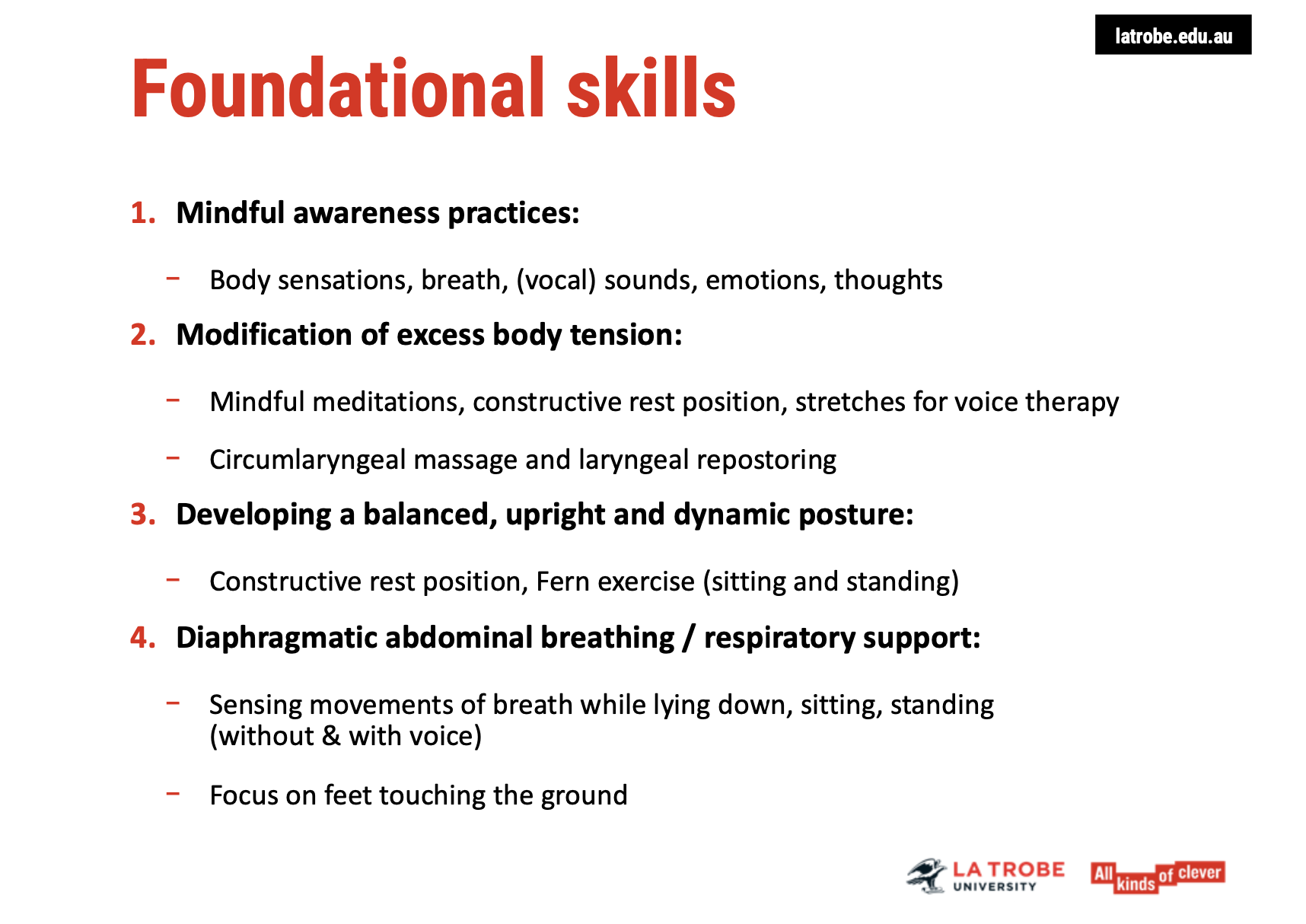Targets, approaches and foundational skills
1/7
There's no tags or description
Looks like no tags are added yet.
Name | Mastery | Learn | Test | Matching | Spaced |
|---|
No study sessions yet.
8 Terms
Six Target Areas of Voice Therapy
1. Speaker Practices
Focus: The client’s own behaviour and efforts in managing their voice.
Includes techniques like breathing exercises, posture adjustments, and voice exercises to support vocal health and production.
Aims to enhance self-awareness and empower the client to take control of their voice use.
2. Conversation Partner Practices
Focus: How others engage with the client during communication.
Training family, friends, or colleagues to provide appropriate feedback and encourage healthy voice habits.
Encourages active listening and adjustments in conversational style that promote healthy voice production (e.g., reducing ambient noise, respecting vocal rest periods).
3. Professional Practices
Focus: Professionals working with the client, such as speech pathologists, physiotherapists, counsellors, or ENT specialists.
Collaborative approaches are needed, integrating expertise across disciplines.
Professionals provide tailored interventions and ongoing support.
4. Sociocultural and Physical Environment
Focus: External factors that influence voice production, including workplace settings, home environment, and community interactions.
Includes addressing factors such as noise levels, speech demands, and workplace ergonomics.
Encourages advocacy for changes in the environment to support functional voice production (e.g., reducing loud background noise or increasing accessibility to voice care).
5. Biophysiological Processes
Focus: Physiological aspects that impact voice, such as breathing, muscle function, and general health.
Includes posture correction, muscle relaxation techniques, and addressing respiratory patterns that support proper voice use.
6. Medical Interventions
Focus: Any medical or surgical interventions needed to address underlying health issues affecting voice production.
Could involve medication or medical procedures like surgical correction or physical therapy to address underlying causes of voice dysfunction.
Collaborative approach with medical professionals to ensure the health issues are managed alongside voice therapy.
Integration of Targets
These six areas are interconnected and not isolated.
In practice, multiple targets will often be addressed simultaneously.
Holistic approach is essential, as working on just one area may not be enough to address all the contributing factors to the client’s voice difficulties

Speaker Practices Breakdown
1. Sociocultural Belonging
Focus: The identity and social positioning of the speaker.
This includes factors like gender, sexual orientation, profession, disability, and ethnicity.
Important to explore how the speaker identifies and how they wish to express their sense of belongingwithin various social contexts.
The speaker may have specific preferences regarding how they want to be perceived, addressed, and treated in social interactions (e.g., choosing certain vocal characteristics to align with their identity).
2. Voice Use and Self-Presentation Practices
Focus: How the speaker uses their voice and presents themselves to others.
This includes how they manage their tone, pitch, and delivery in different contexts.
It's about aligning their voice use with their personal goals, professional demands, and social contexts.
Effective self-presentation can support the confidence and clarity with which they engage in various environments (work, family, public speaking).
3. Lifestyle, Voice, and Self-Care Practices
Focus: The speaker’s self-care and voice maintenance routines.
This encompasses healthy habits, such as hydration, rest, and nutrition, which directly affect voice health.
It also involves establishing practices like vocal warm-ups, relaxation techniques, and strategies to reduce vocal strain.
Self-care routines help in sustaining long-term vocal health and minimizing the risk of voice disorders.
4. Responses to Stressors
Focus: How the speaker emotionally and physically reacts to stress and challenges.
This can include emotional responses (e.g., anxiety or frustration), cognitive responses (e.g., negative thought patterns), and behavioral responses (e.g., voice tension or poor posture).
Addressing these responses helps in managing stress-related impacts on voice production.
The aim is to help the speaker recognize and regulate their responses to avoid detrimental effects on voice quality.
Integration
These subcategories of speaker practices are interwoven and can influence each other:
Sociocultural factors affect self-presentation, which impacts voice use.
Self-care and stress management strategies are critical for maintaining consistent, healthy voice production.
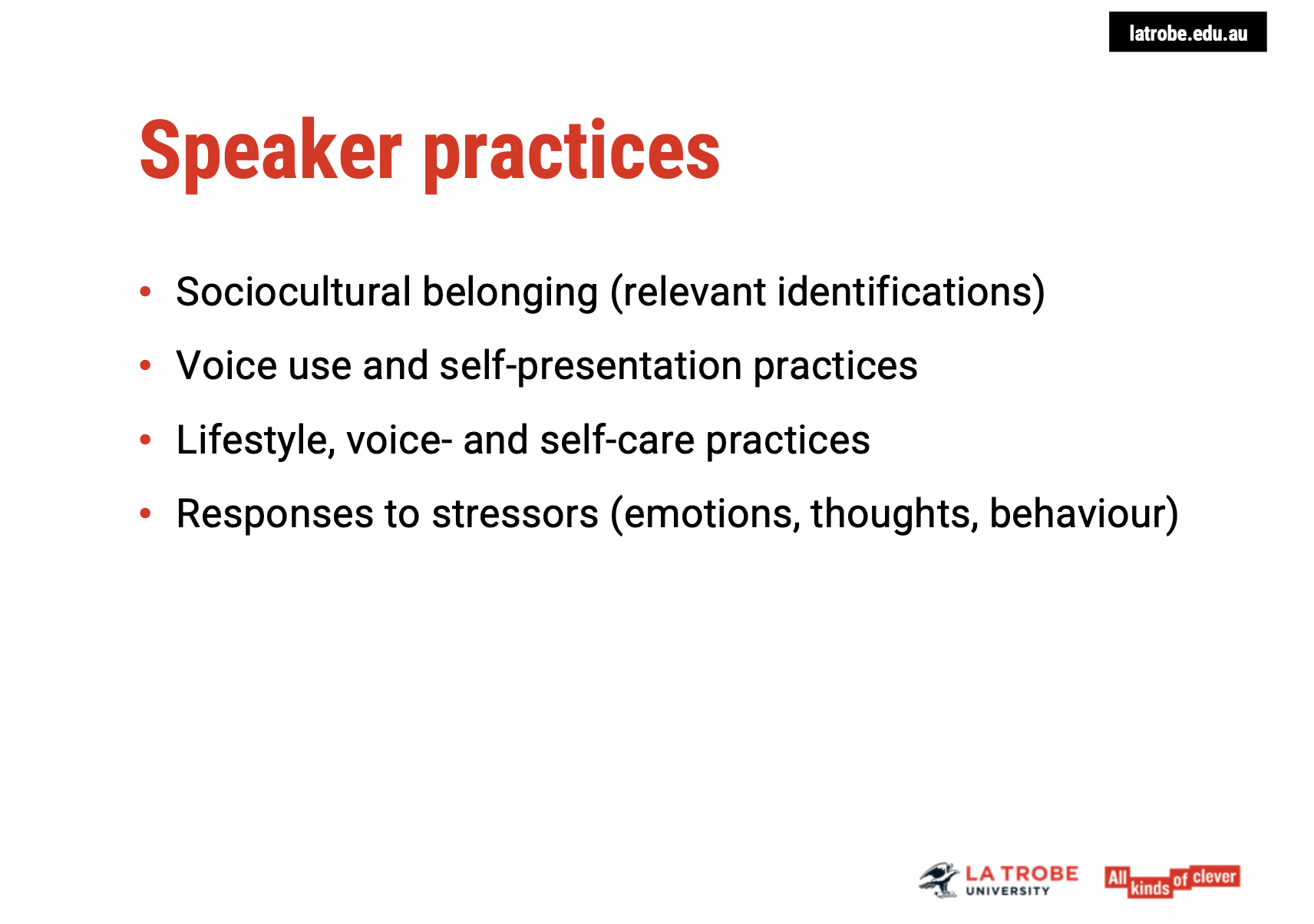
🔄 Types of Voice Therapy Interventions
1. Direct Interventions
Focus: Modifying the physiology of voice production.
Key Areas:
Auditory Awareness: Training the speaker to hear and recognise their voice quality, pitch, and resonance.
Somatosensory Awareness: Focusing on body sensations related to voice use, helping the speaker become aware of muscle tension and posture.
Musculoskeletal Function: Techniques to improve posture and release muscle tension that may affect voice production.
Respiratory Function: Enhancing breathing techniques for better breath support and control during speech.
Vocal Function: Targeted practices to improve vocal strength, endurance, and stability.
Resonance: Techniques to refine the resonance of the voice, ensuring it’s clear and appropriate for different situations.
2. Indirect Interventions
Focus: Managing etiological and contributing factors affecting voice health.
Pedagogy:
Goal: Providing knowledge and strategies to help modify vocal health and usage.
Educating clients on proper vocal hygiene, healthy voice habits, and how to prevent vocal strain.
Offering strategies for managing specific voice-related challenges, such as improving breath support or vocal endurance.
Counselling:
Goal: Addressing psychosocial factors that may impact vocal health.
Identifying issues like stress, anxiety, or emotional strain that could negatively affect voice production.
Offering coping mechanisms and supportive therapy to help manage emotional triggers related to voice use.
Overlap Between Direct and Indirect Interventions
While direct interventions focus on the physical aspects of voice production, indirect interventions work on mental, social, and psychological factors. Both approaches can complement each other, and a well-rounded voice therapy plan often involves both direct and indirect methods for optimal results.
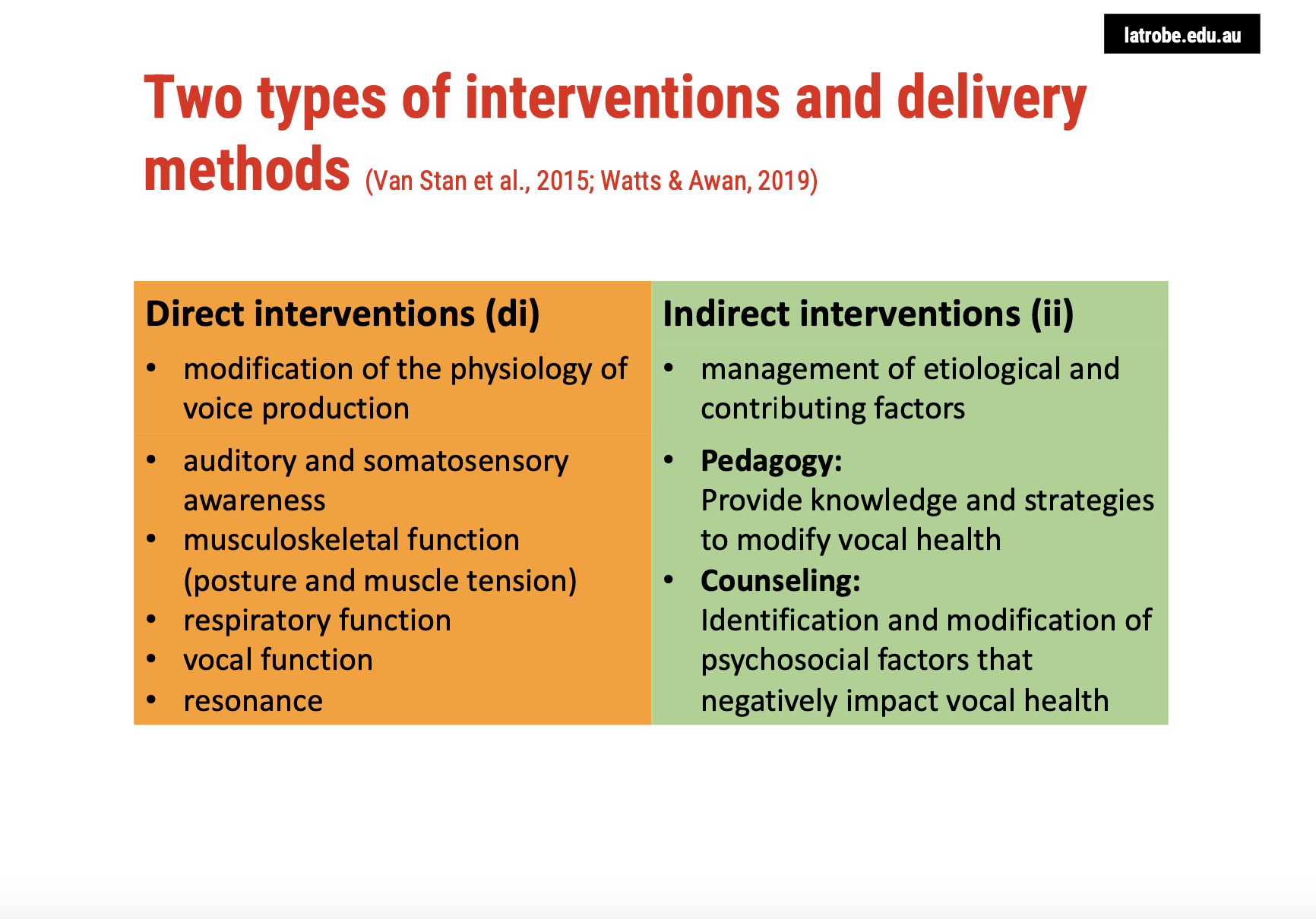
Integrating Interventions with Voice Therapy Targets
1. Speaker Voice Use and Self-Presentation Practices
Intervention Type: Direct Interventions
Focus: Modify physiological aspects of voice production and refine self-presentation practices.
Goal: Ensure the speaker's presentation aligns with functional voice production principles.
Example: Teaching posture, breath support, and vocal control to enhance self-presentation during public speaking or professional voice use.
2. Speaker Lifestyle and Self-Care Practices
Intervention Type: Indirect Interventions
Focus: Address lifestyle factors impacting vocal health.
Goal: Provide informational counselling, voice care education, and support for behaviour change.
Example: Offering advice on healthy vocal habits, creating a voice care routine, and encouraging the maintenance of helpful behaviours to avoid strain.
3. Speaker Responses to Stressors
Intervention Type: Primarily Indirect Interventions
Focus: Address the psychosocial factors and stress responses that can affect voice use.
Goal: Replace habitual stress responses with more effective self-care practices and assertive communication.
Example: Implementing mindfulness practices to improve body awareness, breath control, and emotional regulation, reducing the impact of stress on voice production.
Overlap: Some direct interventions (e.g., mindfulness) can also enhance stress management by increasing awareness of bodily sensations, breath, and voice.
Overall Strategy
The integration of direct and indirect interventions aims to promote holistic voice health by addressing both the physical and psychosocial aspects of voice production.
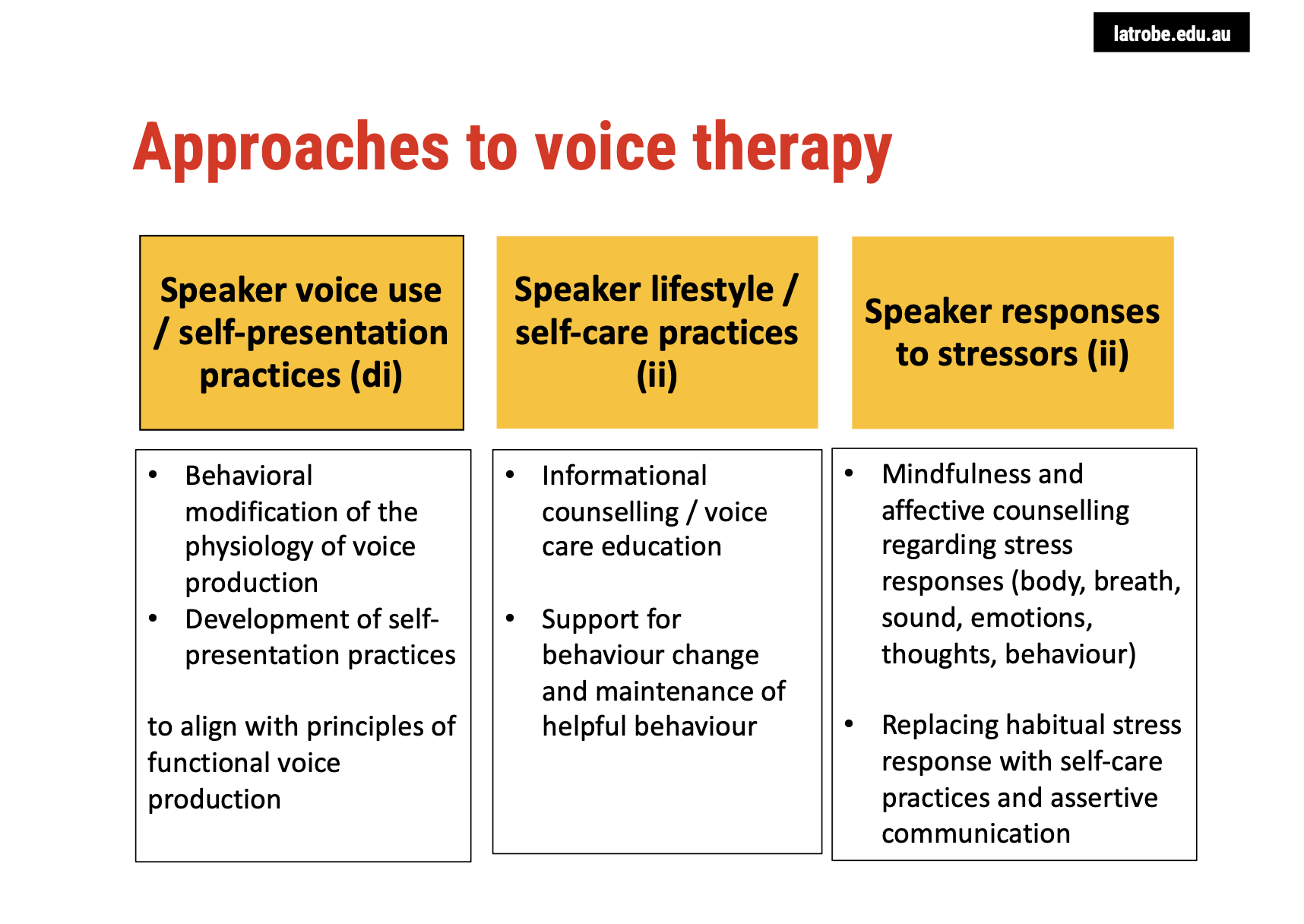
Indirect Interventions: Supporting the Voice Therapy Process
1. Conversation Partner Practices
Intervention Type: Indirect Interventions
Focus: Modify interaction dynamics between the client and significant others.
Goal: Help clients identify barriers and facilitators in how others communicate with them, and advocate for necessary changes.
Approach:
Discuss important individuals (e.g., family, colleagues) whose behaviour impacts voice production.
Joint sessions may be conducted with the client and significant others to directly address communication practices.
Alternatively, the client is taught strategies to advocate for changes to their conversation partner's practices.
2. Professional Practices
Intervention Type: Indirect Interventions
Focus: Engage in professional development to enhance knowledge and skills.
Goal: Increase understanding of the relationship between stress responses, nervous system functioning, and voice production.
Approach:
Learn about sociocultural positioning, self-presentation practices, and their impact on voice health.
Share knowledge with other professionals, enhancing the support system for clients experiencing voice difficulties.
3. Sociocultural and Physical Environment
Intervention Type: Indirect Interventions
Focus: Address the sociocultural factors affecting the client's voice health.
Goal: Provide informational counselling to help clients respond to norms, expectations, and policies in a way that supports voice production.
Approach:
Sociocultural forces (e.g., gender, social expectations) are explored, and the client is encouraged to develop helpful responses to these influences.
Self-advocacy is encouraged, both for the client and the clinician, to promote changes that support functional voice production.
Overall Strategy
Indirect interventions address broader environmental and relational factors, empowering clients to navigate sociocultural influences and professional settings while promoting changes to external factors that may hinder voice production.
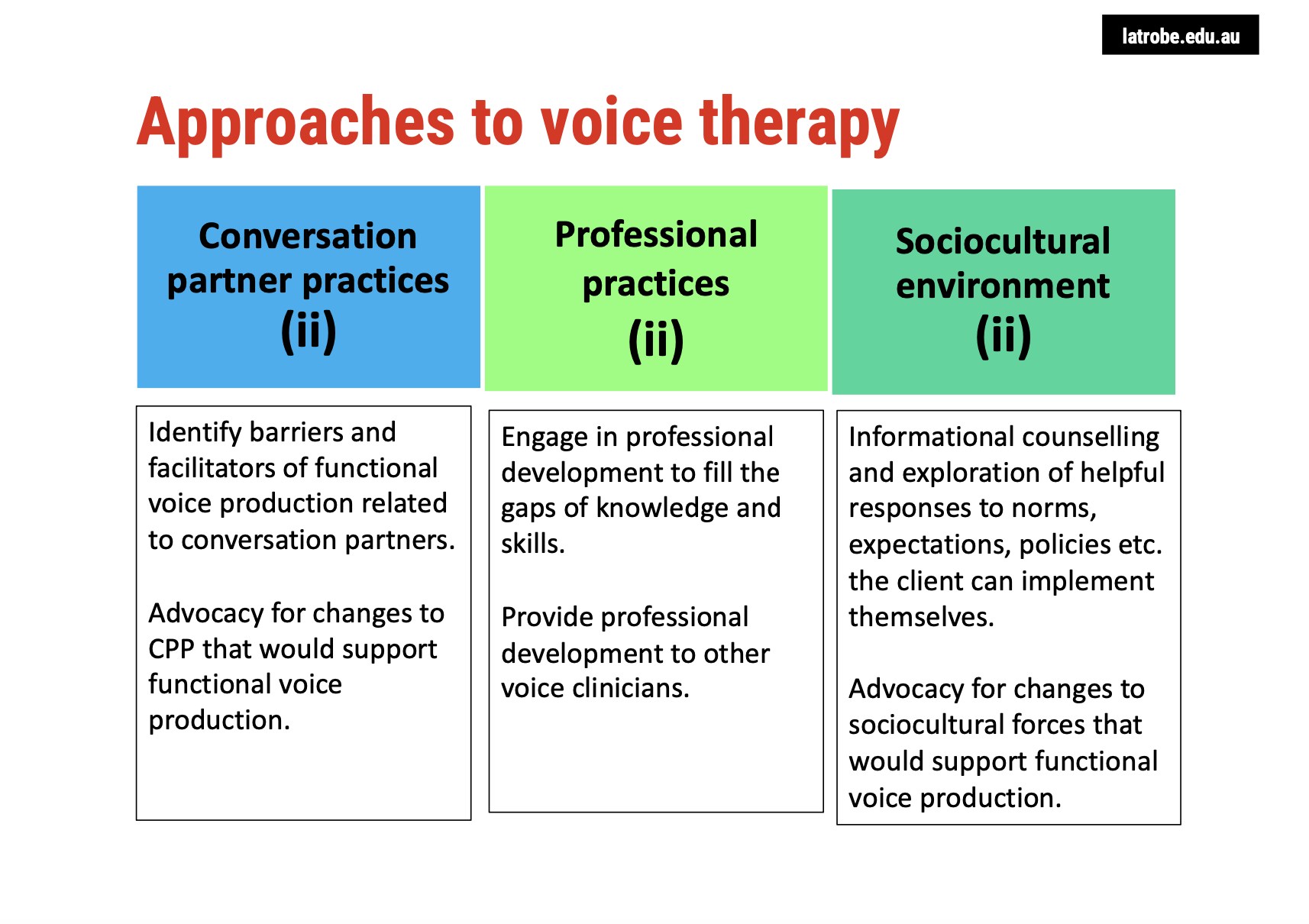
Supporting the Physical and Biophysiological Environment
1. Physical Environment
Intervention Type: Indirect Interventions
Focus: Modify physical surroundings to promote voice health.
Goal: Ensure that the client's environment supports functional voice production.
Approach:
Provide informational counselling about how the physical environment can affect voice function.
Help clients identify and implement modifications to their environment (e.g., acoustics, ergonomics) to reduce strain on their voice.
Advocate for environmental changes that better support the client’s vocal needs.
2. Biophysiological Forces & Medical Interventions
Intervention Type: Indirect Interventions
Focus: Address the biophysiological processes that influence voice production.
Goal: Educate clients on how biophysiological factors impact their voice health and ensure proper medical care.
Approach:
Provide informational counselling on how bodily processes (e.g., muscle tension, breathing patterns) influence vocal production.
Explore and recommend healthcare practices that can help the client maintain or improve their voice.
If necessary, refer the client to a medical practitioner (e.g., ENT specialist) for medical intervention if issues are beyond the scope of therapy.
Overall Strategy
The focus of indirect interventions in this area is to provide clients with the knowledge and tools to modify their physical surroundings and healthcare practices, empowering them to take charge of their voice health while ensuring they have access to appropriate medical support when needed.
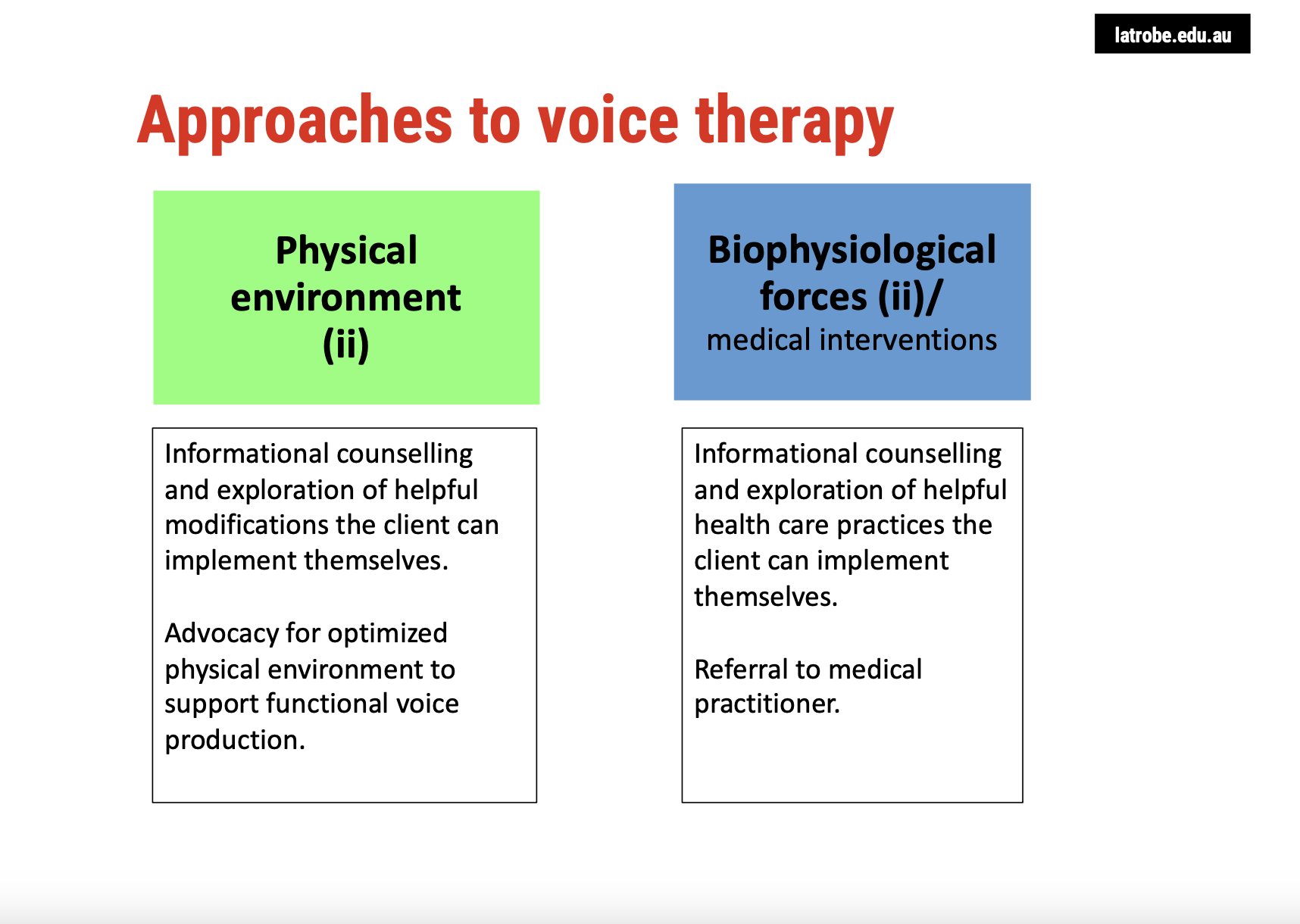
Suggested Order of Treatment Techniques
1. Foundational Skills
Goal: Focus on basic voice and self-care practices to ensure proper foundation for voice production.
Approach:
Establish strong self-care practices and effective modification of the sociocultural and physical environment.
Ensure the client develops a strong understanding of their voice, body, and health in relation to vocal production.
2. Physiological Modification Techniques
Goal: Address specific physiological features involved in voice production.
Approach:
Implement techniques that modify multiple physiological processes (e.g., breathing, muscle tension, posture) that affect vocal function.
Focus on individual aspects such as respiration, phonation, resonance, and articulation for more refined control over voice production.
3. Holistic Techniques
Goal: Coordinate multiple physiological features and integrate them into the entire voice production mechanism.
Approach:
Use holistic techniques that simultaneously address coordination across various voice processes.
The goal is to improve overall vocal efficiency by focusing on the interaction between breath support, vocal fold vibration, resonance, and articulation, while addressing body tension and emotional responses.
This structured progression starts with the development of foundational self-care skills and moves towards more integrated techniques that enhance overall voice production efficiency.
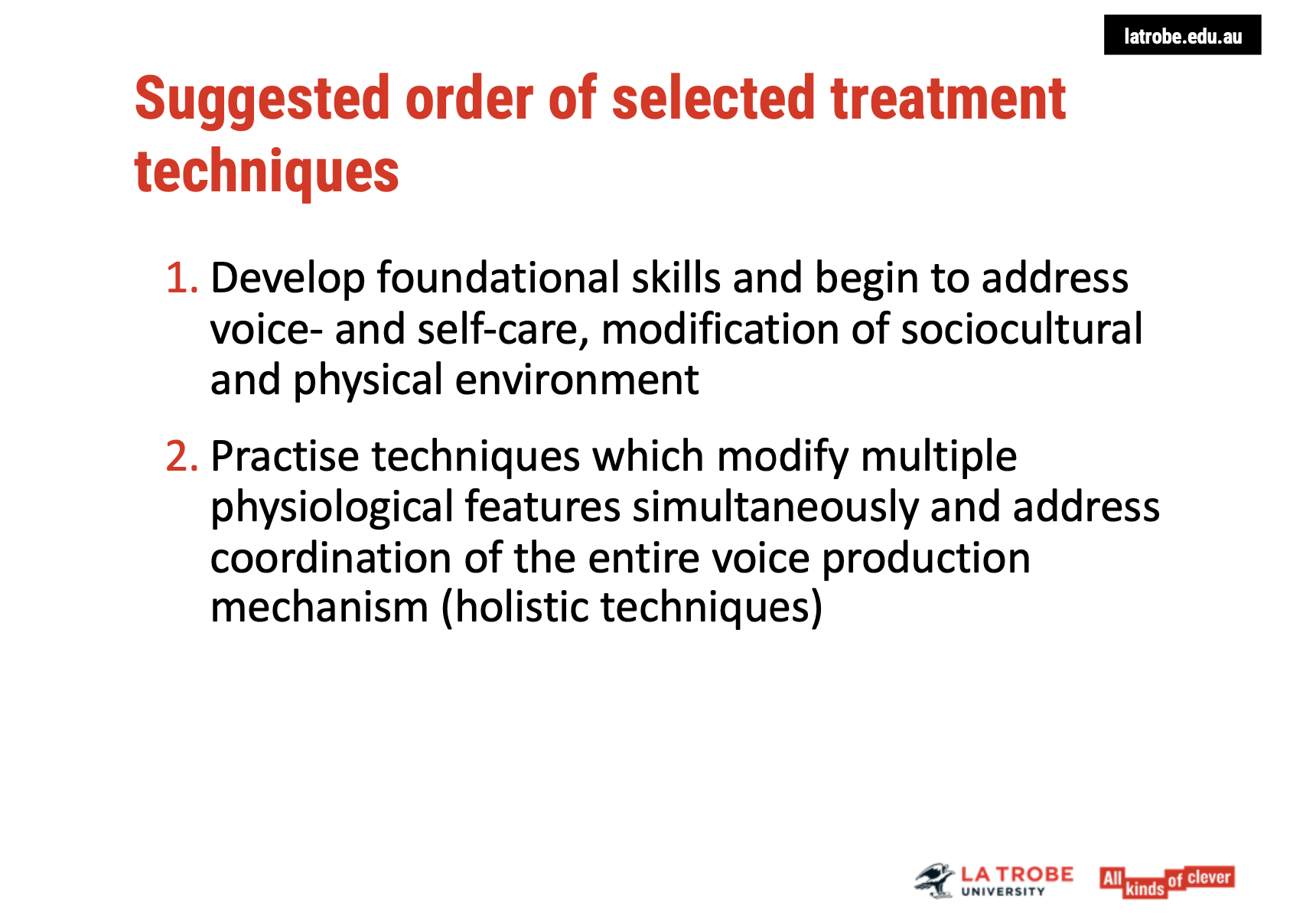
Foundational Skills in Voice Therapy
1. Mindful Awareness Practices
Purpose: Improve awareness of body sensations, breath, voice, emotions, and thoughts.
Benefits:
Helps in noticing changes in the body and emotions that affect voice production.
Promotes stress reduction, relaxation, and release of body tension.
Enhances clarity and focus for better learning and responding to stressors.
2. Direct Modification of Excess Body Tension
Purpose: Address excess body tension, which can negatively impact voice production.
Methods:
Mindful awareness practices.
Constructive Rest Position (from the Alexander Technique): A position that helps release tension and improve posture by lying on the floor, letting the ground support the body.
Specialized Circumlaryngeal Massage: Targets specific areas of tension around the larynx through massage and gentle movement.
Balanced Upright Posture: Exercises, such as the Fern Exercise, help develop a natural and flexibleposture rather than forcing an upright stance.
3. Diaphragmatic Abdominal Breathing & Respiratory Support
Purpose: Build diaphragmatic breathing for better breath control and voice support.
Steps:
Start by sensing breath movements while lying down (hands on tummy, chest, or shoulders).
Gradually transition from lying down to sitting and standing.
Perform breathing exercises without voice initially, then with speaking or sound production.
Use the grounding technique: Feel feet touching the ground to promote stability and effort-free breathing.
Key Principles
Focus on mind-body connection for improved voice production.
Gradual transition from simple to more complex postures and voice exercises.
Integration of relaxation techniques for better control and endurance.
